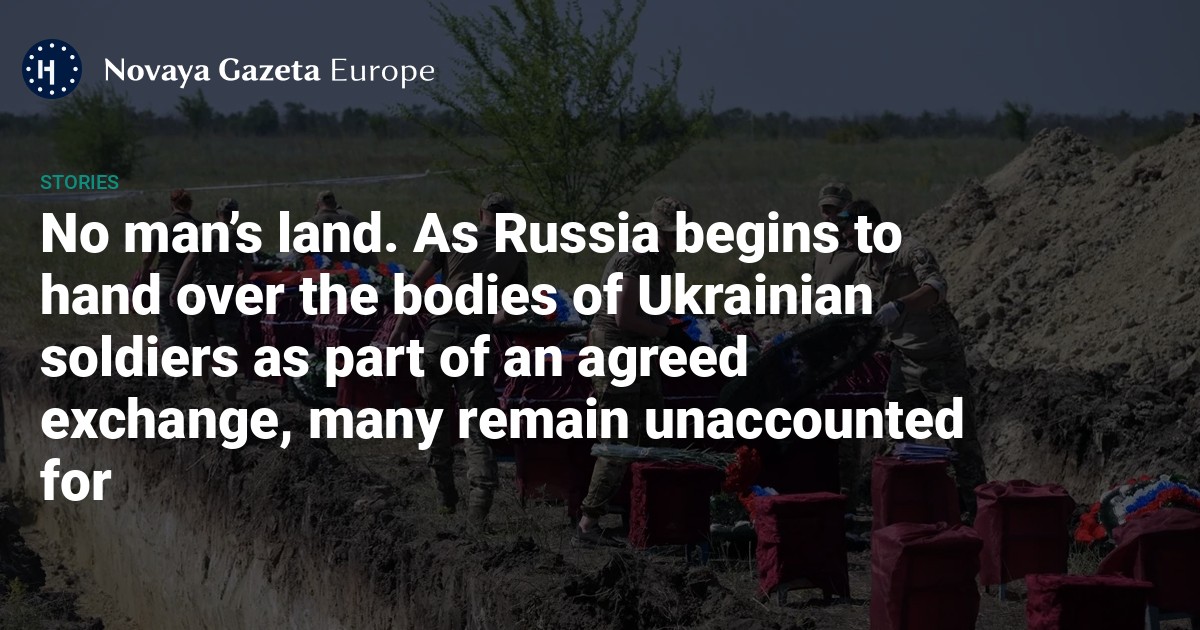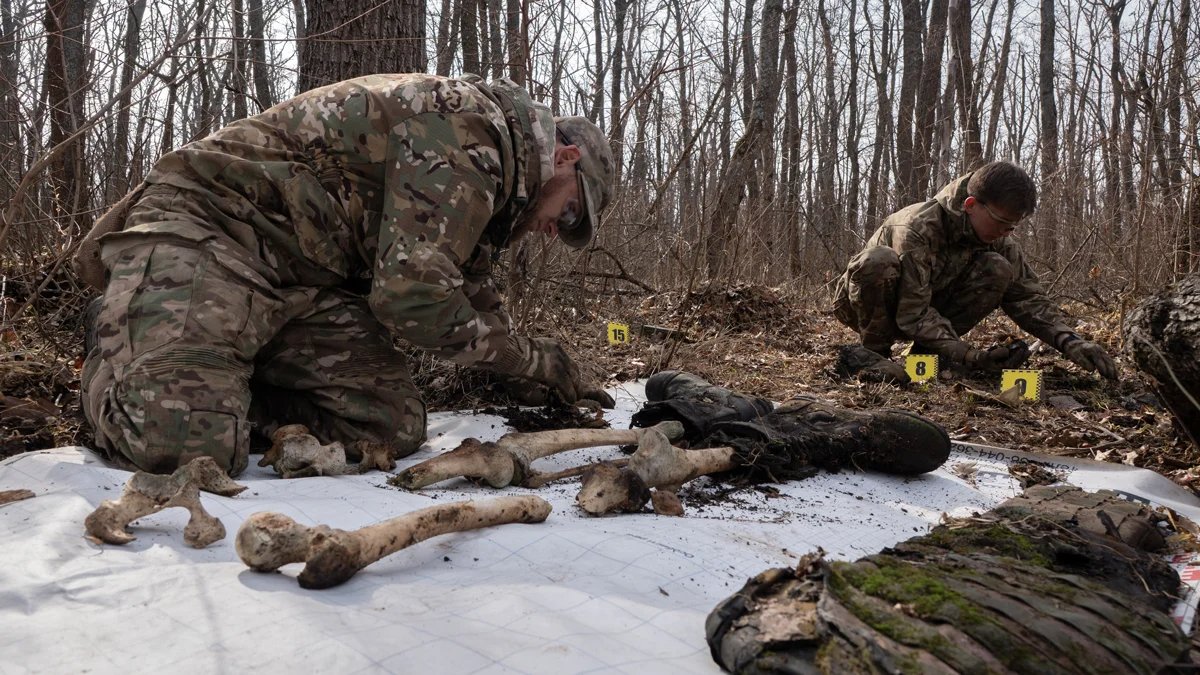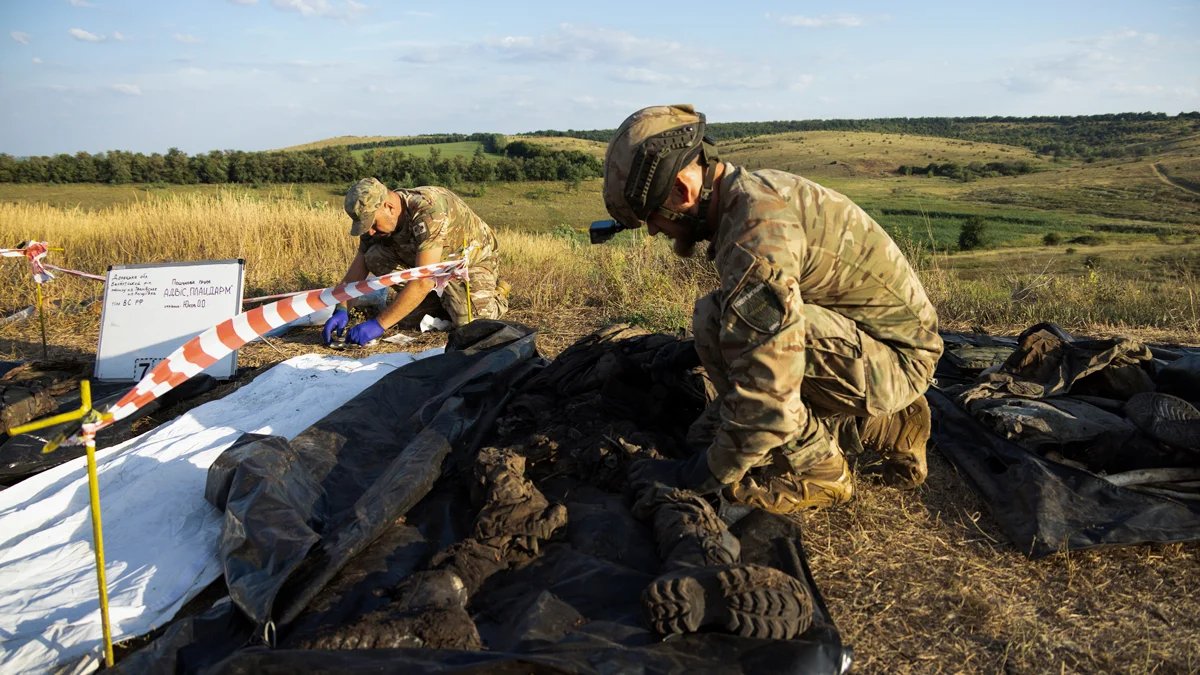



On Wednesday, Moscow transferred the remains of 1,212 Ukrainian servicemen to Kyiv, in the first of a series of transfers expected to take place following an agreement reached during the negotiations in Istanbul earlier this month. But soldiers on both sides of the front line say that many bodies remain unaccounted for, as the two sides are unable to collect them amid constant drone attacks.
Following the negotiations, Ukrainian Defence Minister Rustem Umerov revealed that Ukraine and Russia had agreed to exchange the bodies of 6,000 dead soldiers each at the talks in Istanbul.
However, Ukrainian President Volodymyr Zelensky said that only 15% of the 6,000 fallen soldiers that Russia plans to transfer to Ukraine had been identified, adding that the remains “must all be checked”.
According to international agreements, the bodies of fallen enemy soldiers must be treated with respect. Article 17 of the Geneva Convention states that the parties to the conflict must ensure the proper burial or cremation of the dead, preceded by a “careful examination” of the bodies to confirm the cause of death and establish their identity, with the identity tag remaining on the body.
Bodies can only be cremated if absolutely necessary for sanitary reasons or in accordance with the deceased’s religion. If cremating, the reason should be given on the death certificate or in the certified list of the deceased.
“There was an order from above: ‘We fetch no one!’”
But life and war can rewrite any convention. Alexey, a Russian deserter from the Storm Z assault detachment of former prisoners, says that often, even collecting those killed in action was impossible due to constant drone attacks.
“Our unit … never experienced a ceasefire to exchange bodies,” Alexey, who served as a field hospital nurse in a team tasked with retrieving dead bodies, continues. “We couldn’t even get our own guys. On paper, they had to be reported as missing. Storm detachments evacuate bodies very rarely. There was even an order from above: ‘We fetch no one!’”
“You could walk for hours through the pine forest and there were corpses everywhere,” Alexey, who says he was deployed near the village of Synkivka, in the Kharkiv region, recalls. “Many of them were torn apart, in terrible condition. And you think we’re going to extract Ukrainians?”

Ukrainian volunteers lay out fragments of bodies found in the Kharkiv region on 12 March 2025. Photo: Gwara Media / Hnat Holyk / Scanpix / LETA
“The Russians have a lot of corpses of Ukrainian soldiers because the Russian army is advancing, and the bodies of those who defended the territory come with it,” says Mikhail, call sign Archangel, an officer in a Russian volunteer unit. “In November, a machine buried Ukrainian corpses right there in their trenches near Toretsk. When the front doesn’t move for a long time, a lot of those killed in action accumulate in no-man’s land. As a rule, there are several kilometres between the two sides’ positions. Any remains left there can rot for months,” he continues.
Sometimes, Ukrainian prisoners of war are forced to collect bodies, says Sergey, call sign Maloy, a serviceman fighting near Pokrovsk.
“They get double rations. It’s hard work. But not that dangerous. The Ukrainians won’t fire artillery or drones against their own men. Quite a lot of them get blown up by mines, though. But that’s a matter of fate,” he says.
“There are hundreds, if not thousands of corpses. Most are in very poor condition: disfigured by explosions, or they laid there in no-man’s land and were often eaten by wild animals.”
Nikolay, a military doctor who worked as a surgeon at a military hospital in the occupied Donetsk region in 2023–2024, says that bodies collected on the front line are divided up into Russians, Ukrainians, and those who cannot be identified. The bodies of Ukrainians were frozen and taken to Donetsk or Russia, where temporary morgues have been in use since 2022.
Genetic material is collected from the deceased for DNA testing and sent to a lab in Rostov-on-Don, in southern Russia, Nikolay says. “From there, data on the dead should theoretically be sent to relatives in Ukraine via the Red Cross. But as far as I know, that often doesn’t happen. Previously, lists were compiled for exchanges and most often it was bodies that had been identified and documented that were transferred,” he continues.
Sergey knows of two places where Russia keeps the corpses of Ukrainian soldiers in the occupied cities of Melitopol and in Berdyansk, in southeastern Ukraine. “There are hundreds, if not thousands of corpses. Most are in very poor condition: disfigured by explosions, or they laid there in no-man’s land and were often eaten by wild animals,” Sergey continues.

Members of a Ukrainian search team transport the remains of Russian soldiers near the front line near Bakhmut in the Donetsk region on 1 August 2024. Photo: Nikoletta Stoyanova / EPA
An Armed Forces of Ukraine (AFU) officer with the call sign Kozyr says that on his part of the front, the parties managed to agree on a ceasefire to remove corpses several times.
“It’s not just about caring for fallen comrades, it’s also about basic hygiene. Decomposing remains stink and could poison the water. And dead bodies add nothing to soldiers’ morale. So I personally concluded agreements [with the Russians] so medics could collect the corpses,” he says.
However, such agreements became impossible in 2024 and 2025, he continues, as Ukraine advanced into Russia’s western Kursk region and as Russia fought to recapture territory seized by Ukraine.
“Once, an entire enemy detachment came under mortar fire at once. No one picked up their corpses. No one cared.”
“At the very beginning of the operation in the Kursk region, we sent the corpses of Russians to our rear. Once, an entire enemy detachment came under mortar fire at once. No one picked up their corpses. No one cared,” he recalls. The Ukrainians first sent the bodies to Sudzha, a town in the Kursk region that had been under AFU’s control for months until Russia recaptured it in March, and then onto Sumy, in northeastern Ukraine.
“We could have buried them, but the brigade commander decided not to. We collected whoever we could and put them in a truck. I’m not sure we had the same number of arms and legs as we did heads,” he says.
AFU serviceman Oleksiy, with the callsign Sniper, who has been fighting since 2015, said: “Over the winter, we did nothing with the enemy dead. We just left them there. In the summer, however, we had to bury them. The stench was terrible. We handed over their documents, chevrons and phones to the Security Service of Ukraine (SBU). We didn’t go near their personal belongings, watches, money or clothes. Once we took their crappy helmet and armour as museum pieces, but not from dead bodies! They just lay there.”
AFU soldier Oleh, call sign Fierce, who is now fighting near Sumy, says: “We didn’t collect enemy corpses. We can barely get our own, never mind the enemies’. Enemy drones mean we can’t get the dead or even the injured off the battlefield. Bodies lie in no-man’s land for months. When it’s warm, you can barely breathe for the smell. But I’ve never heard of a ceasefire being declared so that remains could be collected.”
The Russian government has banned independent media. We were forced to leave our country in order to keep doing our job, telling our readers about what is going on Russia, Ukraine and Europe.
We will continue fighting against warfare and dictatorship. We believe that freedom of speech is the most efficient antidote against tyranny. Support us financially to help us fight for peace and freedom.
By clicking the Support button, you agree to the processing of your personal data.
To cancel a regular donation, please write to [email protected]
VPNovaya
Help Russians and Belarusians Access the Truth
